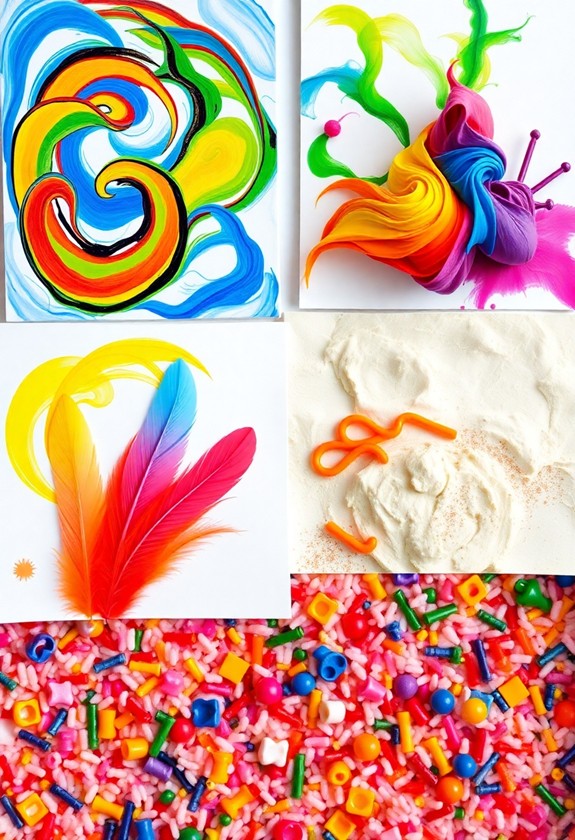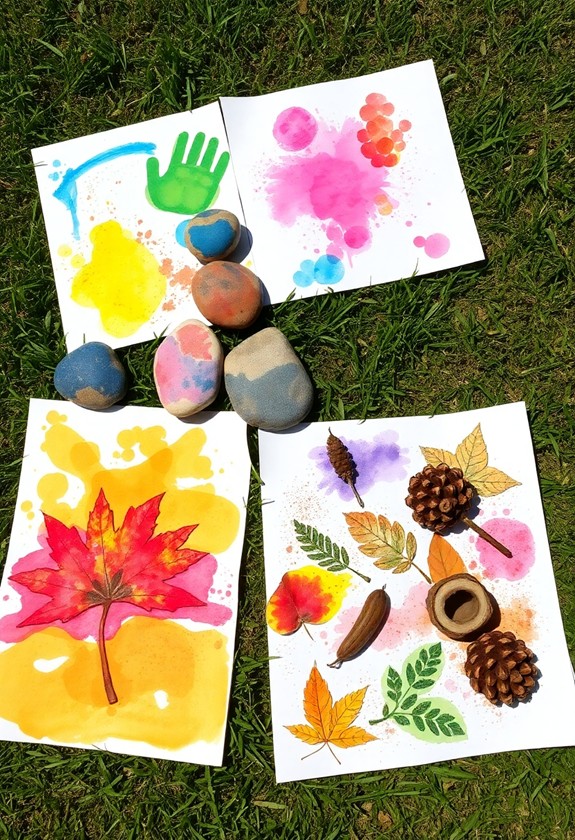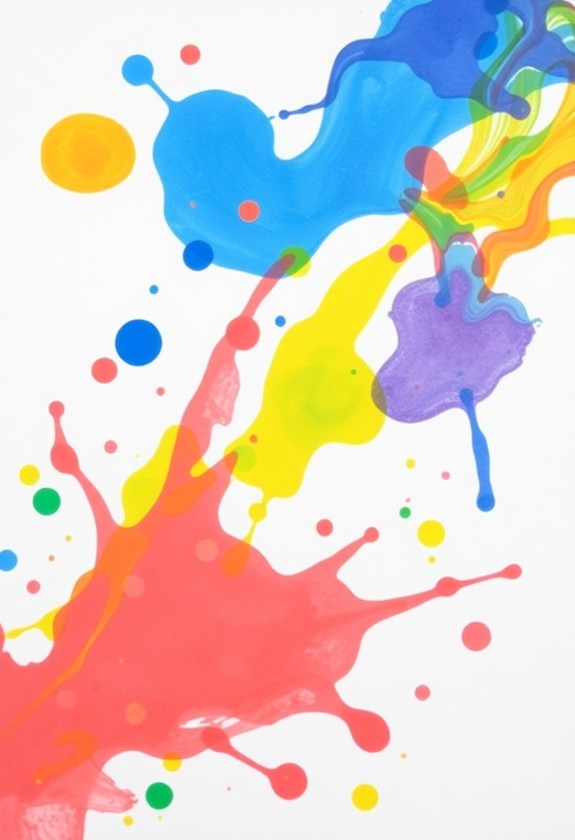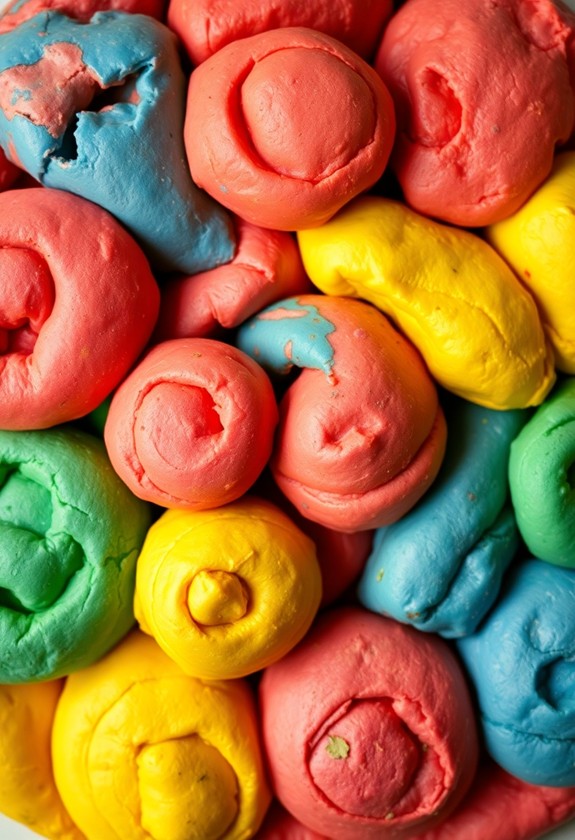Unlock a world of sensory wonder for your little adventurers with these engaging art experiences! Let them squish and stretch colorful spaghetti for tactile fun, or create textured collages using various materials. Encourage creativity with scented play dough sculpting, and immerse in nature-inspired sensory bins filled with leaves and pebbles. Turn snack time into art time with edible finger painting, using yogurt and food coloring. And don't forget sound-making art tools like jingle bell brushes for a musical twist! These activities will spark imagination, develop fine motor skills, and create lasting memories. But wait, there's so much more to uncover in this sensory art adventure!
Creative Highlights
- Multi-sensory art activities engage multiple senses, enhancing memory retention and information processing in early childhood development.
- Sound-making art tools like bubble wrap rollers and jingle bell brushes transform painting into interactive auditory experiences.
- Tactile exploration through colorful spaghetti painting and textured collages promotes sensory investigation and fine motor skills.
- Scented play dough sculpting combines olfactory stimulation with creative expression, fostering cognitive development and dexterity.
- Nature-inspired sensory bins encourage hands-on exploration of various textures while promoting learning about the environment.
Colorful Spaghetti Painting
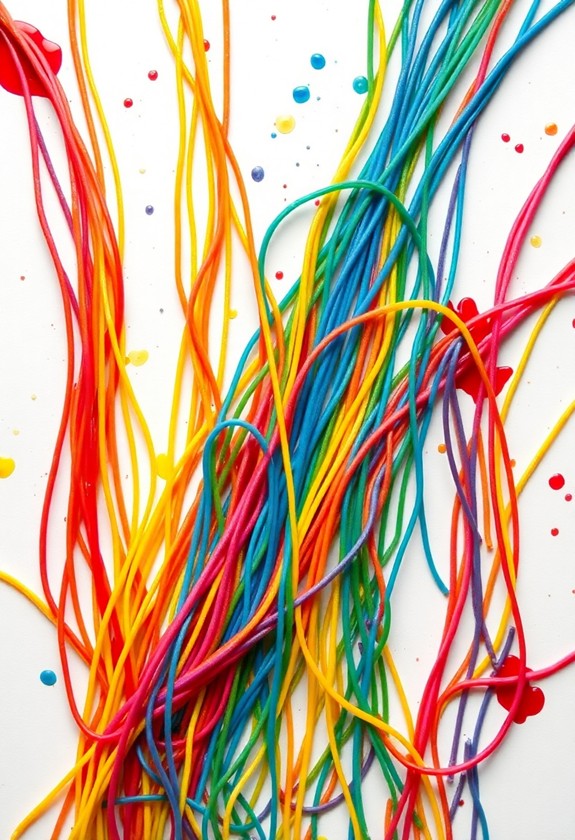
Imagination soars when little hands immerse into a world of colorful spaghetti. This messy, lively activity is perfect for your little adventurers to engage their senses and create unique masterpieces! Multi-sensory experiences like this aid in memory retention and information processing, essential for early childhood development.
What you'll need:
- Cooked spaghetti
- Food coloring
- Large trays or containers
- Paper
Let's get started!
First, cook the spaghetti until it's nice and soft. Divide it into separate bowls and add different food coloring to each. Mix well – it's like giving the pasta a colorful makeover!
Now, spread the rainbow spaghetti onto trays or containers. Your little artists can jump right in! Encourage them to squish, squeeze, and stretch the noodles. It's a texture bonanza!
Time to create! Place paper on the tray and let your kids use the spaghetti as paintbrushes. They can swirl, dab, or drag the noodles to make unique patterns. Who knew pasta could be so artsy?
As they play, ask questions about how the spaghetti feels. Is it slimy? Smooth? Cold? This sensory investigation is a feast for their developing minds!
Textured Collage Creation
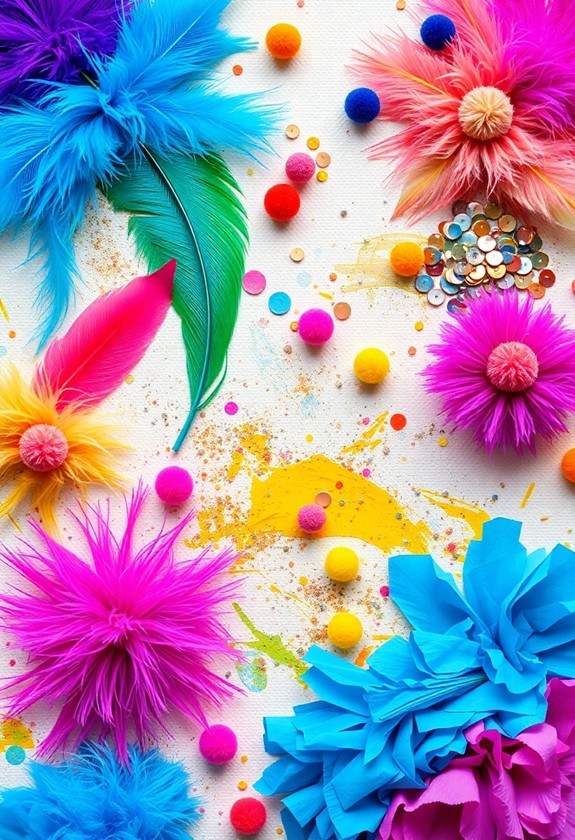
Immerse yourself in the world of textures with this engaging collage activity. It's time to get your hands busy and your senses tingling! You'll transform everyday materials into a masterpiece that's not just visually stunning, but also a treat for your fingertips. This activity is perfect for enhancing fine motor skills and encouraging self-expression through art, making it an ideal choice for toddlers and young children.
Gather Your Materials:
- Cardboard or thick paper for the base
- Glue (the stickier, the better!)
- Scissors (safety first, little artists!)
- Various textured items (get creative!)
- Paint or markers for extra pizzazz
Let's jump in! Start by laying out your base. Now, here comes the fun part – reveal your inner texture detective! Scour your home for items with interesting feels. Soft cotton balls, rough sandpaper, smooth pebbles – the world is your tactile oyster! Cut, tear, or shape these treasures and arrange them on your base. Don't be afraid to mix and match – that's where the magic happens!
Once you're happy with your design, glue everything down. Voila! You've created a touchable work of art. But wait, there's more! Add splashes of color or patterns to make your collage pop. Remember, in the world of sensory art, there are no rules – only endless possibilities for exploration and fun!
Scented Play Dough Sculpting
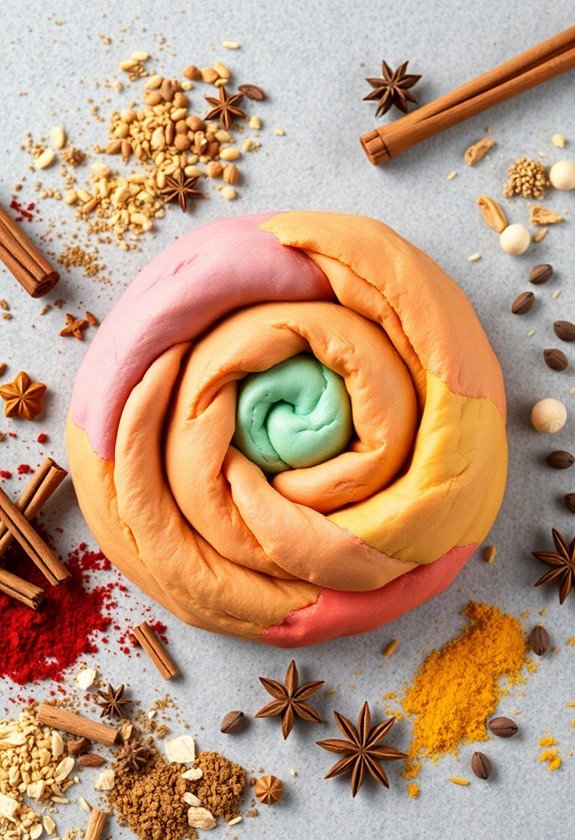
Now let's awaken another sense with a hands-on activity that's guaranteed to delight. Get ready for scented play dough sculpting! This fun-filled adventure will have your little ones squishing, molding, and sniffing their way to artistic glory. Crafting promotes development in various areas, including fine motor skills and cognitive abilities, making it an excellent choice for toddlers.
First, whip up a batch of homemade play dough. It's easy! Mix flour, salt, water, and food coloring. But here's the twist: add a dash of vital oils or extracts for a burst of fragrance. Lavender, lemon, or vanilla work wonders!
Now, let the sculpting begin! Encourage your budding artists to create anything their hearts desire. Flowers, animals, or even a scented pizza – the possibilities are endless! As they work, their senses will be in overdrive. They'll feel the soft, pliable dough between their fingers and inhale the delightful aromas.
Want to kick it up a notch? Try these scent-sational ideas:
- Create a "guess the smell" game
- Make a scented garden scene
- Sculpt fruit-scented food items
This activity isn't just fun – it's additionally great for developing fine motor skills and creativity. So, get ready to nose-dive into a world of aromatic art!
Nature-Inspired Sensory Bins
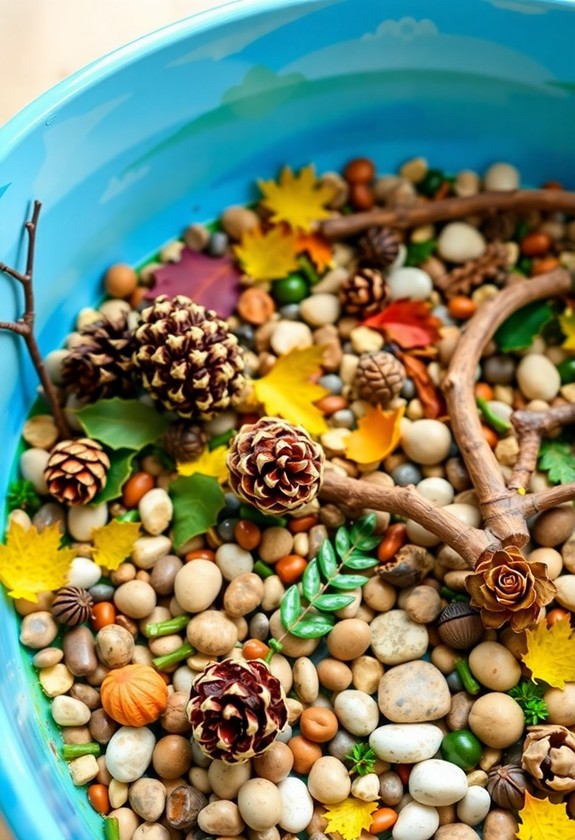
Ready to bring the great outdoors inside? Nature-inspired sensory bins are a fantastic way to engage your little adventurer's senses as you nurture a love for the environment. These magical bins are packed with natural elements that'll make your child's imagination soar! Bright colors and patterns in these bins can stimulate cognitive development and bring joy to your toddler's playtime experience.
Here's what you'll need to create your own nature-inspired sensory bin:
- A large, shallow container
- Natural materials like leaves, twigs, and pebbles
- Sand or dirt (depending on your theme)
- Small toys or figurines
- Scoops, cups, or other tools for investigation
Start by choosing a theme for your bin. Will it be a beach, forest, or garden? Let your creativity bloom! Fill the container with your base material, then add natural elements and toys. Voilâ! You've created a mini-world for endless inquiry.
Watch as your little one digs, scoops, and sorts through the bin. They'll be learning about textures, shapes, and natural materials without even realizing it! It's a win-win situation: they're having a blast as they develop essential sensory skills. So, get ready to unleash your child's inner nature lover with these exciting, hands-on sensory bins!
Edible Finger Painting Fun
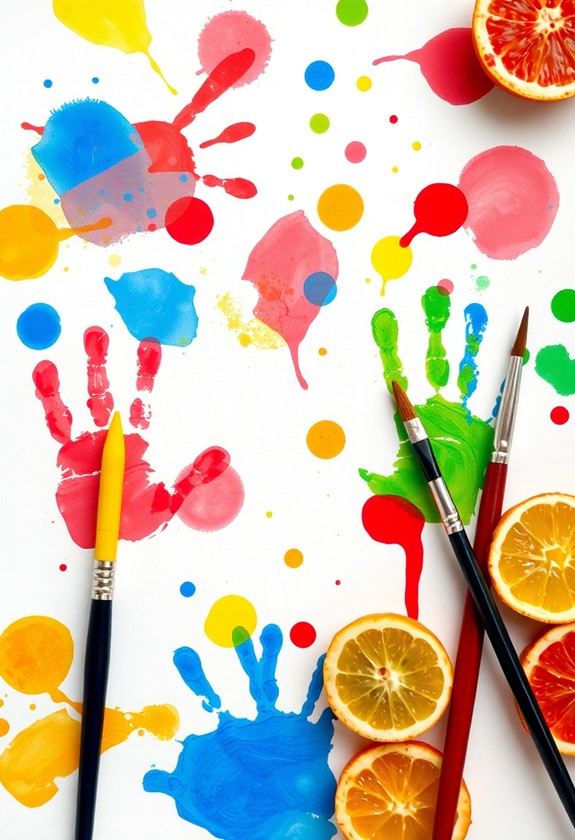
Finger painting takes on a whole new level of fun when it's edible! Your little artists will love creating masterpieces they can actually taste. Let's plunge into this deliciously messy adventure!
What You'll Need:
- Plain yogurt
- Food coloring
- Large paper or plastic plates
- Smocks or old t-shirts
Let's Get Started:
- Mix yogurt with different food colors in separate bowls.
- Spread out your "canvases" (plates) on an easy-to-clean surface.
- Dress your tiny Picassos in smocks to protect their clothes.
- Let the finger-licking fun begin!
Encourage your kids to swirl, smear, and splatter their edible paints. They can create rainbows, monsters, or abstract masterpieces – the sky's the limit! And the best part? If they get a little hungry mid-creation, it's perfectly fine to taste-test their artwork. This activity not only promotes creative expression but also improves fine motor skills and sensory exploration, much like using washable dot markers.
But wait, there's more! Try using other edible paints like pudding or applesauce. You can even add flavors like vanilla or cinnamon for a sensory explosion. It's a feast for the eyes and the taste buds!
Sound-Making Art Tools
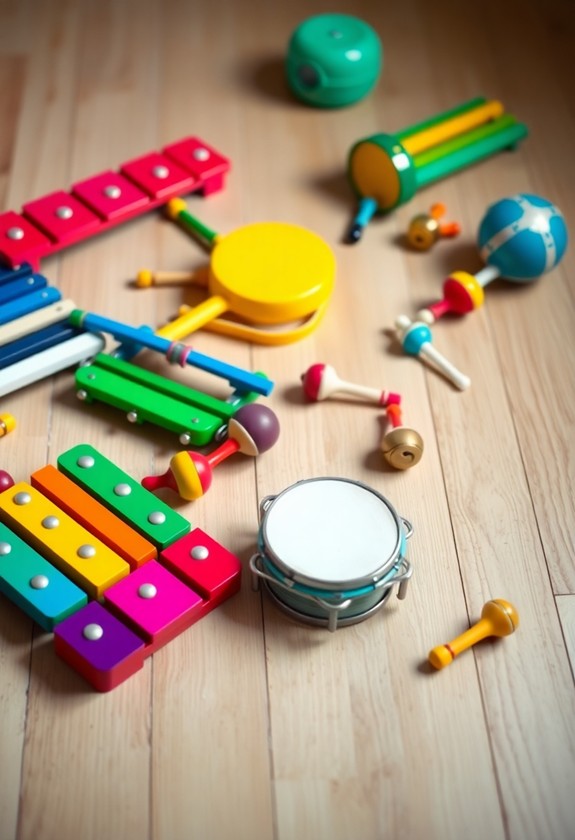
Artistic noise-makers can transform your child's creative experience into a multi-sensory adventure. Sound-making art tools are a fantastic way to engage your little adventurer's auditory senses as they create masterpieces! These tools not only produce lively colors but generate exciting sounds, making art time a harmony of creativity.
Here are some fantastic sound-making art tools to try:
- Bubble wrap rollers: Paint-filled rollers that pop as they roll!
- Jingle bell brushes: Paintbrushes with tiny bells attached
- Shaker paint bottles: Filled with colorful paint and small beads
- Musical stampers: Stamps that play notes when pressed
- Squeezable paint tubes: Make funny noises as paint is squeezed out
Get ready for a noisy, messy, and incredibly fun art session! Let your child experiment with these tools, encouraging them to listen closely to the sounds they make. They'll be creating art that's music to their ears – literally! As they paint, stamp, and squish, they'll develop fine motor skills and sensory awareness. So, grab those noisy tools and let the artistic cacophony begin! Your little Picasso will be making a racket – and memories – in no time!
Curious Little Questions
How Can I Make Sensory Art Activities Safe for Children With Allergies?
You'll be the world's greatest allergy-safe art guardian! To make sensory art activities safe for children with allergies, start by knowing each child's specific allergies. Use hypoallergenic materials like rice, pasta, or sand instead of common allergens. Always check labels! Clean surfaces thoroughly, and keep separate tools for allergy-free projects. But wait, there's more! Encourage hand-washing before and after activities. And don't forget to have a blast during creating masterpieces! Safety first, fun second – it's a winning combo!
What Age Group Are These Sensory Art Experiences Most Suitable For?
Sensory art experiences are fantastic for kids of all ages! But they're especially magical for little ones aged 2 to 8. These years are prime time for sensory exploration and creativity. Toddlers and preschoolers will love squishing, smearing, and uncovering new textures. Elementary-aged kiddos can plunge deeper into artistic concepts. Remember, every child develops differently, so you can adapt activities to suit your little artist's needs. Get ready for some messy, marvelous fun that'll have your kiddo giggling with glee!
How Do I Clean up After Messy Sensory Art Activities?
Cleaning up after messy art activities can be a breeze! Start by covering your workspace with old newspapers or plastic tablecloths. When you're done, simply roll them up and toss 'em out. For paint spills, act fast! Use baby wipes or damp cloths to wipe surfaces clean. Don't forget to rinse brushes and tools right away. And here's a fun tip: turn cleanup into a game! Challenge kids to a "beat the clock" tidying race. It's a win-win: clean space and happy faces!
Can These Activities Be Adapted for Children With Special Needs?
Like a chameleon changing colors, these activities can be adapted to suit children with special needs. You'll find it's a breeze to modify sensory art experiences! Adjust textures, use bigger tools, or simplify steps. For visual impairments, focus on touch and sound. For mobility challenges, bring materials to the child. Don't forget to contemplate sensory sensitivities and provide alternatives. With a dash of creativity and a sprinkle of patience, you'll create a magical world of art for every little adventurer!
How Often Should I Introduce New Sensory Art Experiences to Children?
You'll want to keep things fresh and exciting! Introduce new sensory art experiences every 1-2 weeks, but don't rush it. Let kids fully investigate each activity before moving on. Mix it up with different textures, colors, and materials. Remember, repetition is key for learning, so it's okay to revisit favorites. Watch for their reactions – if they're still engaged, stick with it longer. If they're getting bored, it's time for something new. Keep the creativity flowing!

